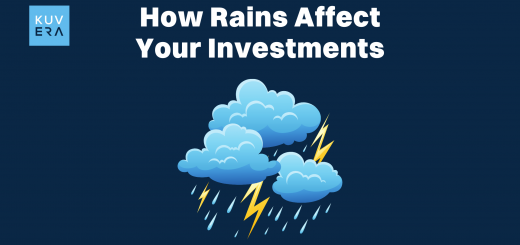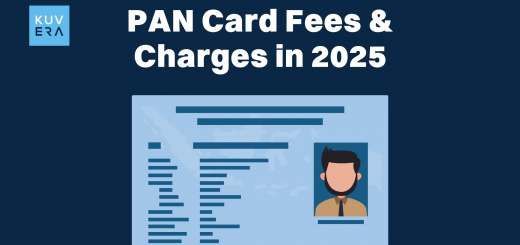Introduction
Many investors become alarmed and start to doubt their long-term investment strategy during erratic periods. This is particularly true for new investors, who may frequently feel tempted to leave the market altogether and wait until it feels secure to return. It’s important to understand that market volatility cannot be avoided. The short-term ups and downs of the markets are bound to happen. Timing the market is a very challenging endeavour. Maintaining a long-term perspective while ignoring short-term changes is the preferred solution. Even long-term investors need to be aware of the unpredictable nature of stock markets and the precautions they can take to avoid them. This post will demonstrate how to accomplish it.
Volatility: What Is It?
Volatility is a statistical measurement of a market’s or a security’s propensity to rapidly rise or fall in value. Usually, the standard deviation of the investment return over a specific time period is used to measure it. The square root of the variance of returns is the term used in statistics to describe the amount of variation or departure that might be anticipated.
Based on how much and how frequently their prices or returns fluctuate over a given time period, the volatility of various investment kinds will differ. A more stable investment, like a sovereign gold bond, will often have a standard deviation of practically zero because the return never varies. Volatile markets are typically characterised by significant and quick price changes as well as active trade. They may be brought on by an imbalance of trade orders moving in only one direction (for example, all buys and no sells). Some claim that factors such as economic releases, corporate news, analyst recommendations, well-known IPOs, and unexpected earnings outcomes are to blame for turbulent markets. Others blame day traders, short sellers, and high-frequency companies for the volatility. Whenever fear or uncertainty in the market increases, volatility can also increase. Although there is no agreement on what causes volatility, investors must learn how to manage it because volatility persists.
Investing For T Long Term In A Volatile Market
Avoiding volatility altogether is one strategy for dealing with it. This entails maintaining your investment and ignoring transient changes. It can often be more difficult than it seems to watch your portfolio lose 50% of its value during a down market. But the conventional wisdom holds that the greatest strategy for dealing with unpredictable markets for the majority of long-term investors is to remain composed and stick with the plan. However, maintaining the course depends on developing a well-rounded and sound strategy at the beginning. One prevalent fallacy regarding the buy-and-hold approach is that it will always be profitable to own a company for 20 years. Because company fundamentals are what drives markets, long-term investing still necessitates due diligence.
The company’s long-term value won’t be impacted by short-term changes if you locate one with a solid balance sheet and stable earnings. In fact, if you think a company is strong over the long term, volatile times may be a wonderful time to acquire.
The key justification for the buy-and-hold strategy is that skipping the best few days of the year would drastically reduce your return. The statistic would typically sound something like this: “Missing the 20 best days might cut your return by more than half,” albeit it depends depend on where you got your statistics from. Most of the time, this is accurate. However, skipping the 20 worst days will also significantly enhance your portfolio, so in some circumstances, you would wish to make transactions while the market is choppy.
What Might Happen to Investment During Volatile Times
Investors, particularly those who use an online broker, should be aware that many brokerages apply policies intended to reduce their exposure to excessive market risk during periods of extreme volatility.
There are other differences in how securities are executed when there is significant volume and price volatility. You should be aware of the following things:
- Delays: High trading volumes are often connected with volatile markets, which could lead to execution delays. Due to the enormous volume, orders could be executed at rates that are significantly different from the market price that was being offered when the order was placed. Investors should question companies about how market makers handle order executions during erratic market conditions. As online trading has grown in popularity, we have grown accustomed to expecting speedy executions at prices that are equal to or close to the quotes shown on our internet-enabled devices. Remember that this isn’t always the case.
- Digital Chaos: The capacity restrictions of a system could make it tough for you to carry out your trades. Additionally, if you are trading online, you might experience difficulties logging into your account owing to heavy internet traffic. Due to these factors, the majority of online trading companies provide alternatives such as phone trades or the ability to place an order by calling a broker.
- Inaccurate Quotations: Between the quote you get and the price at which your trade is executed, there may be significant price differences. Remember that even real-time quotes (RTQs) may not reflect what is happening right now in the market in an unstable market environment. Additionally, there is a chance that the quantity of shares (often referred to as the size of a quote) that are offered at a particular price will change quickly.
Mutual Funds Targeting Volatility – Arbitrage Mutual Funds
Despite being equities funds, equity arbitrage funds have a relatively low-risk profile. Arbitrage, as the name implies, is the technique of profiting from the difference in prices of the same securities on two separate marketplaces, such as the spot market, futures market, or two exchanges. In essence, these funds leverage this “mispricing” to buy and sell securities at various prices on various marketplaces.
By speculating on the price difference of equity shares in several markets and/or segments, such as the BSE versus the National Stock Exchange or the spot market (cash segment) versus the futures market, equity arbitrage mutual funds (MFs) seek to provide risk-free returns (derivatives segment). Simultaneous buying and selling positions are established in various market segments for an underlying share or its derivative. This guarantees that the positions are completely hedged so that investors may profit without taking any risks.
Arbitrage Explained Practically
Let us take an example. Let’s say that the current share price for the XYZ company is Rs. 1000 in the cash market and Rs. 1020 in the futures market. The fund manager for the arbitrage mutual fund will buy XYZ equities in cash and sell them in the futures sector while maintaining the same quantity in both deals. The gross profit from this trade is a difference of Rs 10. Equity arbitrage funds obtain a lower risk profile in this way. Practically no loss can be incurred because the positional transaction is completely hedged against any unanticipated price movement.
One of the tactics that arbitrage funds use the most frequently is cash and carry arbitrage, or spot against future. Consider that the spot (cash market) price of a share of ABC business is Rs. 100, while the price of its futures in the derivatives market (futures and options segment) is Rs. 103. By simultaneously purchasing in the cash market and selling in the derivatives market, you can lock in a profit of Rs 3 per share. The profit resulting from the price differential on the trading day will accumulate regardless of the price movement of the share he continues.
If the fund manager is unable to identify any arbitrage possibilities, the idle funds are placed in overnight or called money market instruments to earn interest income. Due to this, equity arbitrage funds carry more cash than other kinds of equity funds.
Risk Associated With Arbitrage Funds
- Up to 35% of the assets of an arbitrage fund may be placed in debt or money market instruments. There may be credit concerns with these securities. Verify the debt portion of the Arbitrage Funds’ credit rating.
- Market conditions have an impact on the returns of arbitrage funds. Futures may trade at a discount to cash values during extremely bearish markets. Arbitrage is challenging in very bearish conditions because short selling is not permitted in India.
- The NAVs of Arbitrage Funds may occasionally decrease because cash and derivatives positions are marked to market. Investors must have enough time horizons for their investments, which must be at least one month for arbitrage funds.
Pros Of Investing In Arbitrage Funds
- Low price risk because Arbitrage Funds’ equity exposure is entirely hedged.
- Arbitrage Funds don’t have credit risk, in contrast to liquid funds.
- Since the stock market guarantees the payment of all future contracts there is low counterparty risk in relation to investments are made by arbitrage funds in futures.
- Possibility of earning returns greater than interest through banks.
- Equity taxation offers an advantage.
Risk Profile And Taxation
Equity arbitrage funds benefit from equity taxation regulations and in terms of risk profile are often treated on an equal footing with liquid funds. Short-term capital gains tax will be charged if you sell your arbitrage fund units for a profit within a year. Equity funds are currently subject to a 15% short-term capital gains tax rate. Long term capital gains tax rate is 10%. If you hold your units in the arbitrage funds for more than a year you will be paying long-term capital gains tax on their redemption.
How To Invest In Arbitrage Funds
Offline Investment Method: You may decide to invest through a broker if you are unsure about your knowledge. However, if you invest in a fund through a broker, you’ll only apply for regular plans that are associated with higher costs in terms of a higher expense ratio. Remember to have the following documents while investing offline:
- ID Verification (Aadhar Card)
- Cancelled cheque.
- Passport-sized images (around 4-5).
- PAN Card (for KYC verification)
Online Investment Methods: Instead of going through the lengthy process of visiting the website of each AMC and then selecting among them, you may compare and choose from more than 1,700 funds on online investment platforms like Kuvera if you don’t want to increase your commission or brokerage costs. Here, you may choose the fund you want to invest in, review its features, compare it to similar plans, and use the SIP Calculator or Lumpsum Calculator to project the value of your investment in the future.
Things To Consider Before Investing In Arbitrage Funds
Every investment demands a thorough investigation and evaluation of variables including the dangers involved, the past performance of the returns, the holdings’ business acumen, etc. Before making a mutual fund investment, an investor should take into account the following:
- Financial Goal: It’s critical to consider whether the fund’s mission is in line with your financial goals before making any investing selections. Try investing in an arbitrage mutual fund if you’re looking for a short-term place to park your money that will provide you with an advantage over debt funds in terms of bigger gains, tax advantages, and minimal risk.
- Measurement of the fund’s performance in both bullish and negative market conditions is essential because it aids investors in choosing a trustworthy fund. Arbitrage Funds are notorious for their lacklustre reliability and are not expected to perform in a constant market. In a calm market, these funds behave more like bond funds, while actively managed equity funds do better.
- Fund House & Management– Various AMCs float a large number of Mutual Funds (Asset Management Companies). The selection of stocks and the distribution of assets are largely determined by the actions of fund houses and fund managers. If the management is competent and experienced enough, the fund will successfully navigate favourable market conditions and generate positive returns.
- The expense ratio, entry load, and exit load are a few of the charges associated with mutual fund investing. Before making investments, investors should consider these fees. Due to the greater number of trades necessary for the acquisition and sale of stock and contracts in numerous markets, arbitrage funds typically have higher expense ratios.
More fundamentals from the portfolio: Other elements, such as the fund’s NAV (Net Asset Value), AUM (Assets under Management), and others, should be considered to ensure the fund’s dependability and investor participation.
Interested in how we think about the markets?
Read more: Zen And The Art Of Investing
Watch/hear on YouTube:
Start investing through a platform that brings goal planning and investing to your fingertips. Visit Kuvera.in to discover Direct Plans and Fixed Deposits and start investing today.
#MutualFundSahiHai #KuveraSabseSahiHai!











